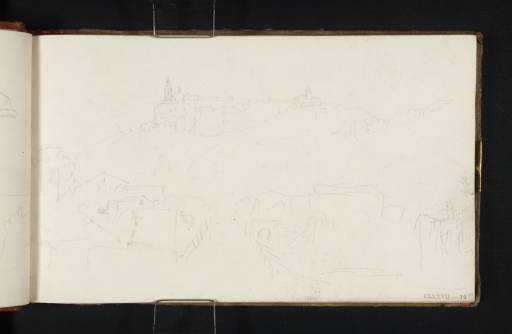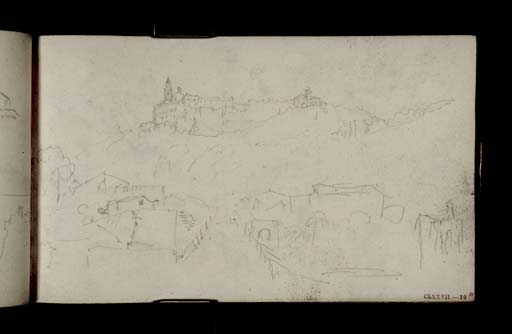Joseph Mallord William Turner Loreto from the Bridge at Villa Musone 1819
Image 1 of 2
Joseph Mallord William Turner,
Loreto from the Bridge at Villa Musone
1819
Joseph Mallord William Turner 1775–1851
Folio 10 Recto:
Loreto from the Bridge at Villa Musone 1819
D14671
Turner Bequest CLXXVII 10
Turner Bequest CLXXVII 10
Pencil on white wove paper, 110 x 186 mm
Inscribed by John Ruskin in red ink ‘10’ bottom right
Stamped in black ‘CLXXVII 10’ bottom right
Inscribed by John Ruskin in red ink ‘10’ bottom right
Stamped in black ‘CLXXVII 10’ bottom right
Accepted by the nation as part of the Turner Bequest 1856
References
1909
A.J. Finberg, A Complete Inventory of the Drawings of the Turner Bequest, London 1909, vol.I, p.520 as ‘Buildings on hill, &c., Loreto’.
1982
Evelyn Joll and Martin Butlin, L’opera completa di Turner 1793–1829, Classici dell’arte, Milan 1982, [p.120] under no.331.
1984
Martin Butlin and Evelyn Joll, The Paintings of J.M.W. Turner, revised ed., New Haven and London 1984, p.185 under no.331.
1984
Cecilia Powell, ‘Turner on Classic Ground: His Visits to Central and Southern Italy and Related Paintings and Drawings’, unpublished Ph.D thesis, Courtauld Institute of Art, University of London 1984, pp.98, 408, 467 note 125, p.468 note 130, reproduced pl.32, as ‘Loreto from the bridge at Villa Musone’.
1987
Cecilia Powell, Turner in the South: Rome, Naples, Florence, New Haven and London 1987, pp.31, 33, reproduced pl.28, as ‘Loreto from the river at Villa Musone’.
Loreto, a famous site of Catholic pilgrimage, is situated on a high ridge of ground overlooking the Adriatic Sea approximately fourteen miles south of Ancona. Turner made a large number of sketches related to the city, both from the outskirts, see folios 6 verso, 9 verso, 10, 10 verso and 13 (D14664, D14670, D14671, D14672 and D14677), and from within Loreto itself, see folios 1 verso, 11, 12, 13 verso, 14 and 29 (D14654, D14673, D14675, D14678, D14679 and D14708). Views and notes dating from the 1819 tour can also be found in the Route to Rome sketchbook (see Tate D13928; Turner Bequest CLXXI 36) and in his personal copy of Reichard’s Italy which he carried with him during his travels (Tate, Turner Bequest CCCLXVII pp.330 and 378). Furthermore, Turner revisited the place a second time on his second Italian tour in 1828–9, see the Rimini to Rome sketchbook (Tate D14869, D14888–D14889 and D14903; Turner Bequest CLXXVIII 21, 32a–33, 41).
Cecilia Powell has identified this sketch as a view of the city on the approach from the north, from the bridge at Villa Musone. On the left can be seen the dome and campanile of the Santuario della Santa Casa, whilst on the right is the circular bastion of the commune and the tower of the Palazzo Comunale. A similar view can be seen on folio 9 (D14670), whilst a more detailed sketch of the bastion can be found on folio 10 verso (D14672). As Powell has discussed the prospect bears a close resemblance to the composition of Turner’s finished oil painting, The Loretto Necklace (Tate, N00509).1 Although this work did not appear in exhibition until the spring of 1829, following Turner’s return from Rome, she has suggested that Turner may have in fact begun working on it in the early 1820s, inspired by his memories and sketches of Loreto in 1819. For some reason the artist then abandoned the picture for some years. However, in 1829 he hastily returned to complete it when other canvases destined for exhibition at the Royal Academy were delayed en routefrom Rome.2
Nicola Moorby
November 2008
How to cite
Nicola Moorby, ‘Loreto from the Bridge at Villa Musone 1819 by Joseph Mallord William Turner’, catalogue entry, November 2008, in David Blayney Brown (ed.), J.M.W. Turner: Sketchbooks, Drawings and Watercolours, Tate Research Publication, December 2012, https://www


